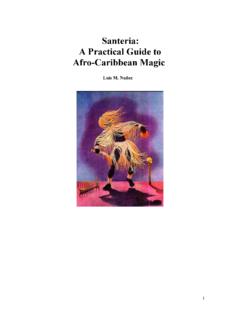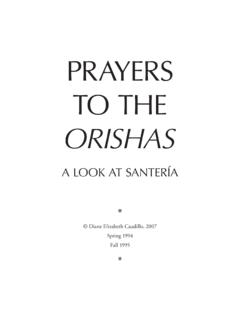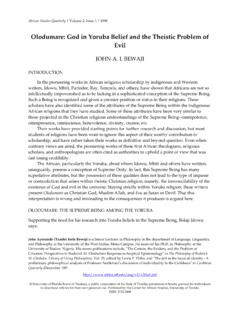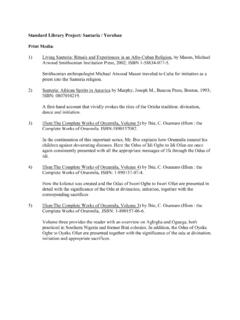Transcription of The Group of Yoruba Gods - Funzione Gamma
1 ----------------- Funzione Gamma , scientific online magazine University "Sapienza" of Rome, registered with the Court Rome Civil (n. 426 of 28/10/2004) The Group of Yoruba gods Enzo Scotto Lavina As recently highlighted, Roger Bastide, the great ethnologist would say everything he knew, aware of knowing little, whilst his pupil and friend Pierre Verger, who undoubtedly knew a great deal would more often than not remain silent. Th odore Monod wrote in the preface of the book Les Dieux d Afrique, Pierre Verger doesn t say or show all because he s also wise, but he delivers us enough.
2 An eerie glimmer in the fullness of human mystery. Abstract This contribution, based on the research carried out by Pierre Fatumbi Verger, intends to look into the following points: who are the Yoruba , the slave trade and syncretism and the orisha pantheon and their archetypes. Key-words: Yoruba Group , trade slave, orisha and their archetypes Introduction The Orishas are Yoruban gods in Africa (Nigeria, Dahomey nowadays called Benin and Togo), from the origins of their lands, the gods spread with the slave trade to Brazil and to the Antilles. Twenty years ago, Pierre Verger dedicated to Orishas, the Yoruban gods in Africa and in the New World, (1981, Editora Corrupio Ltda, Bahia; 1982, Editions Metailie, Paris) a fundamental analysis, summa of his first works of (1) ethnological research and photographical documentation, dedicating it con el carino y amor de Fatumbi to Lydia Cabrera, hija predilecta de Yemaya.
3 This contribution, based on the research carried out by Pierre Fatumbi Verger, intends to look into the following points: who are the Yoruba the slave trade and syncretism the orisha pantheon and their archetypes Who are the Yoruba The term Yoruba today regards ( Biobaku, 1973) a linguistic Group of several million people that share the same language, culture and tradition that originate from the city of Ife (Nigeria). Other researchers, in particular Igue and Obayemi, consider the Yorubans to be a village civilization rather than that of the city, in which each Group feels to be more Ijebu, Ife, Ijesa, Ega, Ondo, etc.
4 , before feeling Yoruban. Instead with the Odoudoua Group there were small settlements in the city of Ifa and subsequent settlements in other centres in far off regions (Dahomey and central Togo) by the Odoudoua descendants. ----------------- Funzione Gamma , scientific online magazine University "Sapienza" of Rome, registered with the Court Rome Civil (n. 426 of 28/10/2004) Slave trade and syncretism Due to the slave trade from various areas of Africa towards the New World, the result was a mixture of prisoners that didn t speak the same language, had different life styles and whom amongst themselves believed in distinct religions.
5 Due to privileged ties between some American countries and certain areas of Africa, in the XVI century Bahia recorded a presence of Bantou Negroes that greatly influenced Brazilian vocabulary, followed by the arrival of a greater number of Africans from the regions of the Dahomeani-gege and from the Yoruba -nago whose worship rituals seem to have been a model for the ethnic groups that had already established themselves in Bahia. For three hundred and fifty years the ships transported not only the bodies of the slaves, but also their personalities, their ways of being and behaving and their beliefs.
6 The slave s religious convictions were immediately put to the test once they had arrived in the New World, where they were forcefully baptized for the salvation of their souls, abiding therefore to the religious doctrines of their masters. The same saints, that had protected the interests of the slave Negro dealers and some of the Negroes that had been transported, subsequently protected the slaves and helped them to mystify their masters, to fool and mislead them on the essence of the dances that they were authorized to perform on Sunday. Hence, the masters, in seeing the slaves dancing and singing in respect to their own customs, thought that this was simply the means by which the Negroes full of nostalgia showed to be having fun, but weren t aware that in reality, during those reunions the slaves were singing prayers of devotion to their Orishas, their Vodoun and their Oriki (traditional hymns).
7 We re not aware of the exact moment in which syncretism was able to develop. It seems to have been generally founded on details of religious images that in certain particularities were able to be tied to some aspects of the African gods . As Nina Rodriguez states; by the end of the XIX century, the Negroes considered their Orishas and the Catholic saints as the same yet different. Although the Negroes appeared to have converted to Catholicism, they were able to practise their own cults sheltered from external influences. Furthermore, due to the frequent relations between the African coast and Bahia, this allowed the re-importation of beliefs and customs that could have been forgotten or modified.
8 The orisha pantheon and their archetypes According to L. Frobenius, quoted by PFV, the Yoruban religion, as it was in 1910, gradually became uniform and this uniformity is the result of adaptations and progressive mixes of beliefs that came from various different directions. PFV states, in commenting Frobenius seventy years later, that an orisha pantheon that has a clear hierarchy, unique and identical in all the areas of the territory called ----------------- Funzione Gamma , scientific online magazine University "Sapienza" of Rome, registered with the Court Rome Civil (n. 426 of 28/10/2004) Yoruba , is still missing.
9 The local variations show that certain Orishas that hold a dominant position in a particular area are completely unheard of elsewhere. Thus, in regards to this extreme diversity, and to these numerous variations of coexistence amongst the Orishas, we can t but remain sceptical in respect to some theogonic concepts too systematically structured. For Verger, the religion of the Orishas is closely bound to the notion of family. An enlarged family, that derives from a common ancestor, that binds the living and the dead. Fundamentally the orisha is a divinised ancestor, that when still alive was able to control a certain number of natural forces, like thunder, wind, fresh and salt waters, or to carry out activities such as hunting, metal work, the knowledge of virtues and the usage of plants.
10 The power of the ancestor orisha , would have the ability, after his death to transmit his power to a descendant during trance possession. The passage from life on earth to the entity of orisha of these exceptional beings, possessors of a mighty power, would usually occur in a moment of passion and frenzy of which legends preserve the memory. These divinised ancestors would not have seemingly died from natural would have undergone a mutation, a metamorphosis, a transformation during those moments of emotional crisis provoked by anger, irritation, regret and by other vehement feelings.









